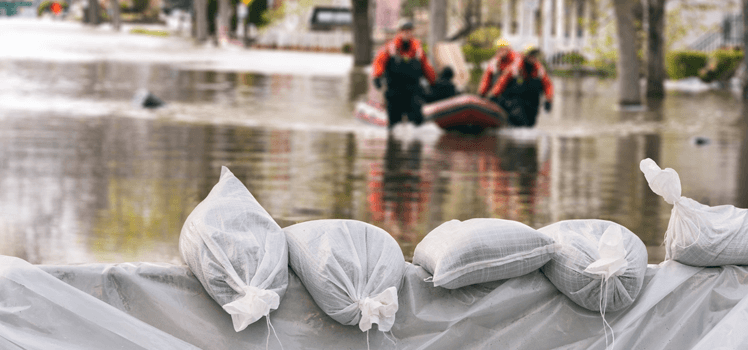Rental property flood risks are a serious issue for landlords and tenants across the country. Flooding in the UK has got significantly worse over the years – more and more homes are being destroyed by burst riverbanks and dangerous record-breaking water levels. Unfortunately, there is no stopping the weather. However, there are actions that landlords can take to protect their tenants, preserve their properties and minimise the effects of flooding.
How does flooding occur?
In the UK, it is estimated that around 3 million properties are at risk from surface water flooding compared to around 2.6 million at risk from river or coastal flooding.
It is important to remember that flooding to a property can be caused by a number of factors, away from the obvious river and sea locations.
Rising water levels, sewers overflowing and run-off from heavy rain can all result in serious flooding.
Surface water flooding occurs when heavy, persistent rainfall does not drain away through existing drainage systems or soak into the ground but lies at the surface or flows over the ground. However, although it is usually short lived and will drain away, the damage can be considerable.
Rental property flood risks: who’s responsible?
Responsibility for flooding is set out in the Flood and Water Management Act (2010), briefly summarised as follows:-
Department for the Environment, Food and Rural Affairs (DEFRA) has the overall national responsibility for flooding. The Environment Agency (EA) is responsible for the strategic overview and Local Authorities (LA) have been given the responsibility for implementing flood risk management, obtaining and sharing information with all relevant public bodies (drainage boards, highway authorities, emergency services and water companies).
The Environmental Agency not only produces flood maps relating to the sea and rivers, but have a long-term flood risk assessment tool on the GOV.UK website.
The maps are colour coded and indicate risk of surface water from the impact of heavy rainfall, defining risk as high, medium, low and very low. They are committed to updating these maps every 6 years.
How do rental property flood risks affect insurance?
Insurers and brokers assess the flood risk in each area and these assessments are used to set premiums.
We spoke to Steve Cox from the Alan Boswell Group who commented:
“Flooding is considered one of the most important factors when insurers calculate landlords insurance premiums. Rising water levels and surface water flooding has been a serious issue for the insurance industry for several years now.
Flooding in some areas has got so bad that the insurance industry and the government are now in talks to agree ways to ensure properties can benefit from flood insurance cover in the future.
Landlords should definitely consider previous flooding (from water courses & surface water) in the local area before investing in property and should make use of the new flood mapping technology that is now readily available online.”
Steve Cox, Alan Boswell Group
The message for Landlords would be to check out all Environmental Agency maps, obtain local information from neighbours and contact insurers for their assessment prior to purchase.
How to protect your property from flooding
Landlord Home Emergency Cover is included in our Complete Plan, or buy separately for £240.00.
Here are some tips on how to protect your property from flooding:
- Secure or store away outside items like garden furniture which could get swept up by the winds and cause damage.
- Make sure your roof gutters and drains are clear of leaves and any blockages so excessive rain can drain away.
- Close and securely fasten doors and windows.
- Park vehicles in a garage if possible or keep vehicles clear of trees and buildings.
- Use a barrier such as a sandbag to help prevent water entering your home. Water can, under extreme flooding, enter via drains, toilets, air-bricks and ventilation openings, so keep an eye on these.
- Move all valuables, electrical equipment and furniture upstairs or buy extra-large sealable bags to protect items.
- Make sure you know where to turn off your gas, electricity and water supplies.
- Ensure tall structures such as chimneys, TV aerials and tall trees are structurally sound.
- Ensure you have bottles of drinking water in case the water supply becomes contaminated.
- Make a list of useful phone numbers you may need.
- Monitor weather warnings on the television, radio or internet.
- Ensure you have candles or a wind up torch.
- Avoid driving if possible. If you have to travel, check the latest travel and weather updates ahead of your journey.
- Follow the advice of emergency services if they tell you to evacuate your home. They will take you to an evacuation centre and provide food and bedding.
Protect your property’s future
All landlord should purchase Building and Contents Insurance for their rental properties. Having insurance in place will protect your home from damages beyond your control such as flooding, fires, burst pipes and gas leaks.
Contact Alan Boswell today for an insurance quote on your rental property.
Have your insurance premiums been affected by flood risk? Please leave your comments below.



